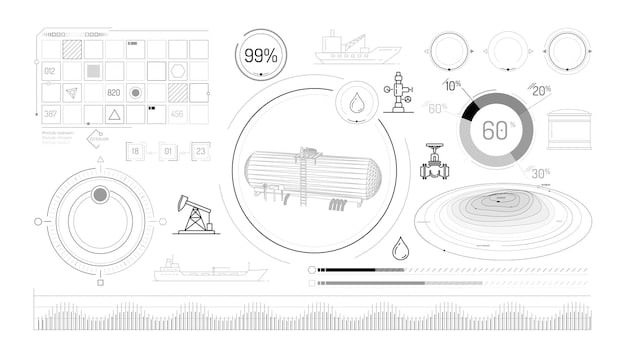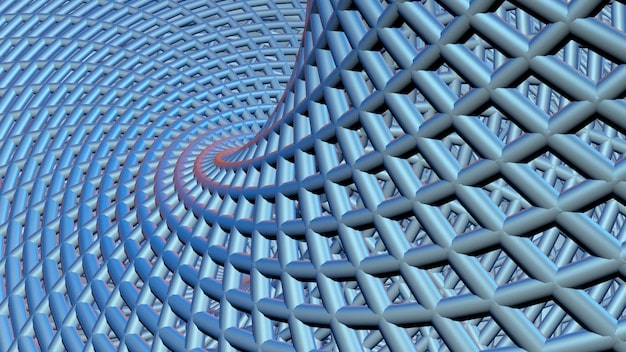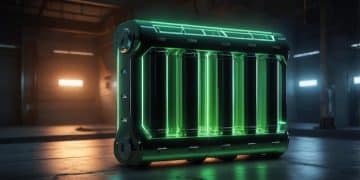Wave Energy Conversion: Latest Tech for US Coasts

Wave energy conversion (WEC) technology advancements for U.S. coastal regions include improved device designs, advanced materials, efficient energy storage, smart grid integration, and enhanced forecasting, optimizing performance and grid stability.
Exploring the **latest advancements in wave energy conversion technology for US coastal regions** offers a promising avenue for sustainable energy production, harnessing the immense power of ocean waves to meet the nation’s growing energy demands.
Understanding Wave Energy Conversion Technology
Wave energy conversion technology is a crucial area of focus as the world shifts towards sustainable energy sources. Harnessing the power of waves can significantly reduce reliance on fossil fuels, especially in coastal regions with abundant wave resources.
These technologies aim to capture the kinetic and potential energy of ocean waves and convert it into usable electricity. Wave energy is predictable and consistent, making it a viable renewable energy source.
Basic Principles of Wave Energy Conversion
Wave energy conversion relies on several physical principles to transform wave motion into electricity. Understanding these principles is key to appreciating the innovative technologies being developed.
- Kinetic Energy Capture: Devices capture the kinetic energy of waves, using their motion to drive mechanical or hydraulic systems.
- Potential Energy Utilization: Some systems use the potential energy of waves, where the height difference between crests and troughs powers energy conversion processes.
- Direct Conversion: Advanced materials and devices directly convert wave motion into electrical energy, eliminating intermediate mechanical steps.

Types of Wave Energy Converters
Several types of wave energy converters have been developed, each with its advantages and suitability for different marine environments. These converters can be broadly categorized based on their technology and deployment.
- Point Absorbers: These devices float on the surface and use the relative motion between the buoy and a fixed structure to generate electricity.
- Oscillating Water Columns: OWC devices trap air above a column of water. Wave motion forces the water column to oscillate, pushing air through a turbine to generate electricity.
- Overtopping Devices: These converters capture water as waves break over them, channeling the water into a reservoir. As the water flows back to sea, it drives a turbine.
In conclusion, wave energy conversion technology offers a sustainable alternative to traditional energy sources, and understanding its basic principles and various device types is crucial for further advancements.
Innovations in Wave Energy Converter Designs
Recent innovations in wave energy converter designs are enhancing their efficiency, durability, and cost-effectiveness. Researchers and engineers are continually developing advanced solutions to harness wave energy more effectively.
These design improvements address challenges such as the variability of wave conditions, the harsh marine environment, and the need for affordable energy solutions.
Advanced Materials
The use of advanced materials is revolutionizing the construction of wave energy converters. These materials offer enhanced strength, corrosion resistance, and longevity in marine environments.
Composites, specialized alloys, and protective coatings are being incorporated to increase the lifespan and reliability of WEC devices.
Smart Design and Control
Smart design and control systems are optimizing the performance of wave energy converters. These systems use sensors, data analytics, and real-time adjustments to maximize energy capture.
Adaptive control algorithms can modify the WEC’s response to varying wave conditions, ensuring optimal energy production.

Modular and Scalable Designs
Modular and scalable designs are making wave energy converters more versatile and adaptable. These designs allow for easy expansion and customization to suit different site conditions and energy needs.
Standardized components and simplified assembly processes reduce manufacturing costs and deployment time.
In summary, innovations in wave energy converter designs are significantly improving the performance and practicality of wave energy as a renewable resource.
Wave Farms and Grid Integration Challenges
Establishing wave farms and integrating wave energy into existing grid systems pose unique challenges. Careful planning, advanced technology, and strategic partnerships are essential to overcome these hurdles.
Grid integration involves ensuring that wave energy can be effectively and reliably transmitted and distributed to consumers.
Wave Farm Development
Wave farms, or arrays of multiple wave energy converters, offer the potential for large-scale energy production. However, their development requires careful consideration of environmental and economic factors.
- Site Selection: Choosing the right location is critical, considering wave resource availability, environmental impact, and proximity to grid infrastructure.
- Environmental Impact Assessment: Thorough assessments are needed to minimize the ecological effects of wave farms on marine life and coastal habitats.
- Community Engagement: Engaging with local communities ensures that wave farm development aligns with their needs and concerns.
Grid Integration Strategies
Integrating wave energy into existing grid systems requires advanced strategies to manage the variability of wave energy output. Energy storage and smart grid technologies play a key role in ensuring grid stability.
- Energy Storage: Battery storage systems and pumped hydro storage can buffer fluctuations in wave energy production, providing a consistent supply of electricity.
- Smart Grids: Smart grid technologies enable real-time monitoring and control of energy flow, optimizing the integration of wave energy into the grid.
- Transmission Infrastructure: Upgrading transmission infrastructure is essential to transport wave energy from coastal areas to inland consumers.
In conclusion, wave farm development and grid integration present complex challenges, but with strategic planning and technological advancements, wave energy can become a reliable component of the U.S. energy mix.
Energy Storage Solutions for Wave Energy
Effective energy storage is vital for addressing the intermittent nature of wave energy. Advances in energy storage technologies are making wave energy more reliable and accessible.
These storage solutions ensure a consistent supply of electricity, even when wave conditions fluctuate.
Battery Storage Systems
Battery storage systems are increasingly being used to store excess wave energy and release it when demand is high. Lithium-ion batteries are a popular choice due to their high energy density and rapid response times.
Advanced battery management systems optimize battery performance and extend their lifespan.
Pumped Hydro Storage
Pumped hydro storage (PHS) involves pumping water uphill to a reservoir during periods of excess energy production and releasing it through turbines to generate electricity when needed. PHS offers large-scale energy storage capabilities.
PHS systems can provide long-duration storage, making them suitable for buffering seasonal variations in wave energy availability.
Hydrogen Production
Hydrogen production via electrolysis is another promising energy storage solution for wave energy. Excess electricity from wave energy converters can be used to split water into hydrogen and oxygen. The hydrogen can then be stored and used in fuel cells or for other industrial applications.
Hydrogen production offers a versatile and long-term energy storage option.
In summary, energy storage solutions are essential for ensuring the reliability and stability of wave energy as a viable renewable energy source.
| Key Aspect | Brief Description |
|---|---|
| 🌊 Advanced Materials | Enhanced durability and corrosion resistance in WECs. |
| 🔋 Energy Storage | Batteries, PHS, and hydrogen for consistent energy supply. |
| 🌐 Smart Grid Integration | Real-time monitoring and control for efficient energy distribution. |
| 📊 Forecasting | Predictive models improve WEC efficiency. |
Frequently Asked Questions About Wave Energy Conversion
▼
Wave energy conversion involves capturing the energy of ocean waves and converting it into electricity. This technology uses devices like point absorbers and oscillating water columns to harness wave motion.
▼
The main types include point absorbers, which float and use relative motion; oscillating water columns, which use air pressure from water movement; and overtopping devices, which capture water in reservoirs.
▼
Wave energy is integrated through grid systems using energy storage solutions like batteries and pumped hydro. Smart grids help manage the variable output, ensuring reliable electricity supply to consumers.
▼
Environmental impacts include disturbance to marine habitats, noise pollution, and potential effects on coastal ecosystems. Careful site selection and environmental assessments can minimize these impacts.
▼
Latest advancements include the use of composite materials, specialized alloys, and protective coatings. These materials enhance the durability and corrosion resistance of wave energy converters in harsh marine environments.
Conclusion
In conclusion, the latest advancements in **wave energy conversion technology for US coastal regions** present a promising pathway for sustainable energy production. With ongoing innovations in device designs, energy storage, and smart grid integration, wave energy is poised to play an increasingly significant role in the U.S. energy landscape.





